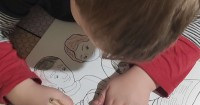Teaching children the coloring skills and their importance
So often, children need to have exposure to crayons and paper for the development of fine motor skills or visual motor skills. Teaching coloring skills is not something parents think about in many cases! Coloring is such an important part of childhood and growing up. There are many benefits to coloring as a tool for building skills. Coloring develops hand strength, visual perceptual skills, and precision skills in grasp. It’s the first time many of us express creativity and produce something we are proud of. It boosts confidence, develops understanding of cause and effect, and increases attention spans. Coloring is also an important stage of child development, too.
How to teach coloring skills
Coloring can be hard for kids. Many times, you see kids that refuse to color. Other times, you come across kids who prefer markers over crayons. There are reasons for these difficulties that make sense developmentally. Here are some of the reasons children find coloring difficult:
- Coloring is HARD!
- The hands hurt to color.
- Coloring makes hands tired.
- The child prefers markers over crayons.
- Coloring in the lines is hard!
- It’s hard to finish a coloring page.
These are some of the reasons kids hate to color, and often, it comes back to a need to develop hand strength and underlying skills.
- Skills needed for coloring
- There are several areas or underlying skills that play an important role in coloring:
- Arch development (for endurance to color in the object)
- Hand strength to move the crayon against a resistive surface
- Pinch and grip
- Precision to move the crayon with the fingers instead of the whole arm/wrist
- Line awareness/visual perceptual skills
- Eye-hand coordination
- Pencil grasp (to hold the crayon)
- Previous experience with fine motor activities/fine motor skill development
Fine motor skills and coloring
Children must develop fine motor skills to hold crayons. , Children need to have the hand strength to color in shape. They also need visual motor skills to color within the lines and to color a whole shape or figure, they need distal mobility. Activities to develop these skills include fine motor play, beading, tweezer use, and working on a vertical surface can develop these skills.
Line awareness and coloring.
Another aspect of coloring is the line awareness of color within the lines. Before a child can form letters easily and fluently, they need to achieve pre-writing lines such as straight lines, squares, triangles, XS, and diagonals. This resource on line awareness can be a great starting point for the visual perceptual skills needed to color within the lines. Also, try these tips to work on line awareness needed for coloring.
Pencil grasp and coloring
It is important to progress through the stages listed below to teach coloring skills, whether at age level or not. Before a child can hold a pencil with a functional grasp, they must progress through more primitive grasp patterns such as a pincer grasp, palmer supinate grasp, digital pronate grasp, and quadruped or static tripod grasp.
All these underlying skills play an important role in teaching coloring skills to kids!

